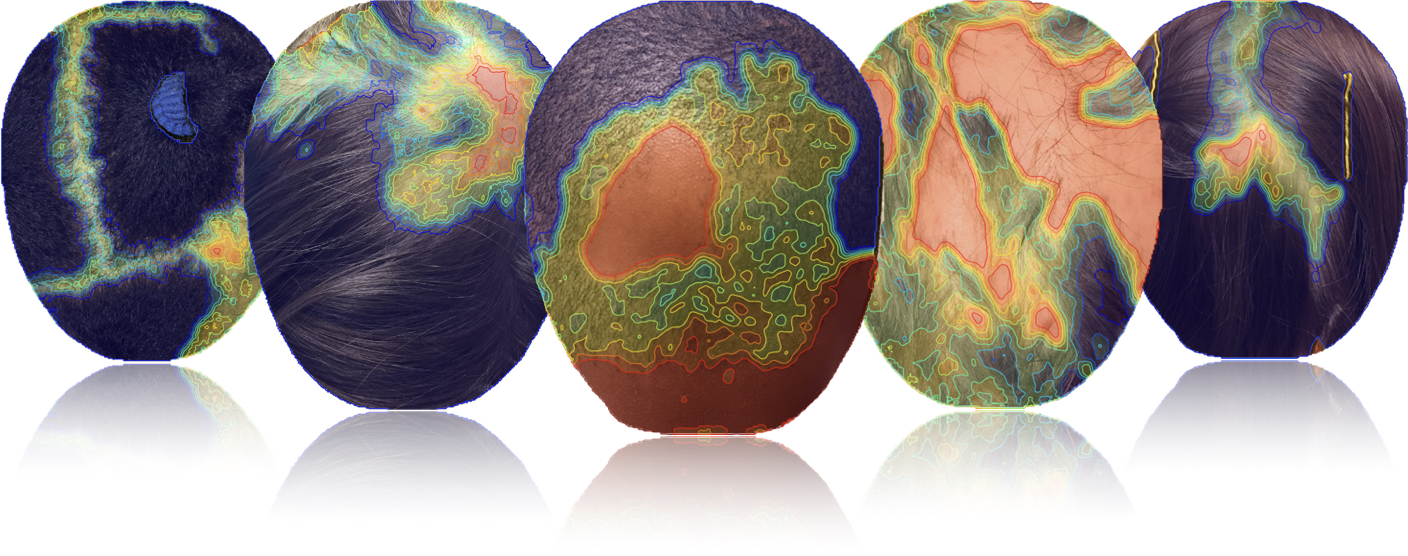
| Cameron J. Gudobba1 | Tejas Mane1 | Aylar Bayramova1 | Natalia Rodriguez1 | Leslie Castelo-Soccio2,3 |
| Temitayo A. Ogunleye1 | Susan C. Taylor1 | George Cotsarelis1 | Elena Bernardis1 |
| 1Dept. of Dermatology, Perleman School of Medicine, University of Pennsylvania |
2Section of Dermatology, Division of General Pediatrics, Children’s Hospital of Philadelphia |
3Dermatology Branch, National Institute of Arthritis and Musculoskeletal and Skin Diseases/National Institutes of Health |

Importance: Clinical estimation of hair density has an important role in assessing and tracking the severity and progression of alopecia, yet to the authors’ knowledge, no automation currently exists for this process. While some algorithms have been developed to assess alopecia presence on a binary level, their scope has been limited by focusing on a re-creation of the Severity of Alopecia Tool (SALT) score for alopecia areata (AA). Yet hair density loss is common to all alopecia forms, and an evaluation of that loss is used in established scoring systems for androgenetic alopecia (AGA), central centrifugal cicatricial alopecia (CCCA), and many more.
Objectives: To develop and validate a new model, HairComb, to automatically compute the percentage hair loss from images regardless of alopecia subtype.
Design, Setting, and Participants: In this research study to create a new algorithmic quantification system for all hair loss, computational imaging analysis and algorithm design using retrospective image data collection were performed. This was a multicenter study, where images were collected at the Children’s Hospital of Philadelphia, University of Pennsylvania (Penn), and via a Penn Dermatology web interface. Images were collected from 2015 to 2021, and they were analyzed from 2019 to 2021.
Main Outcomes and Measures: Scoring systems correlation analysis was measured by linear and logarithmic regressions. Algorithm performance was evaluated using image segmentation accuracy, density probability regression error, and average percentage hair loss error for labeled images, and Pearson correlation for manual scores.
Results: There were 404 participants aged 2 years and older that were used for designing and validating HairComb. Scoring systems correlation analysis was performed for 250 participants (70.4% female; mean age, 35.3 years): 75 AGA, 66 AA, 50 CCCA, 27 other alopecia diagnoses (frontal fibrosing alopecia, lichen planopilaris, telogen effluvium, etc), and 32 unaffected scalps without alopecia. Scoring systems showed strong correlations with underlying percentage hair loss, with coefficient of determination R2 values of 0.793 and 0.804 with respect to log of percentage hair loss. Using HairComb, 92% accuracy, 5% regression error, 7% hair loss difference, and predicted scores with errors comparable to annotators were achieved.
Conclusions and Relevance: In this research study, it is shown that an algorithm quantitating percentage hair loss may be applied to all forms of alopecia. A generalizable automated assessment of hair loss would provide a way to standardize measurements of hair loss across a range of conditions.
If you would like to sign for a future public release of the Trichy app presented in the paper, please email the PI at elber@seas.upenn.edu and include "trichy waitlist" in the subject line.